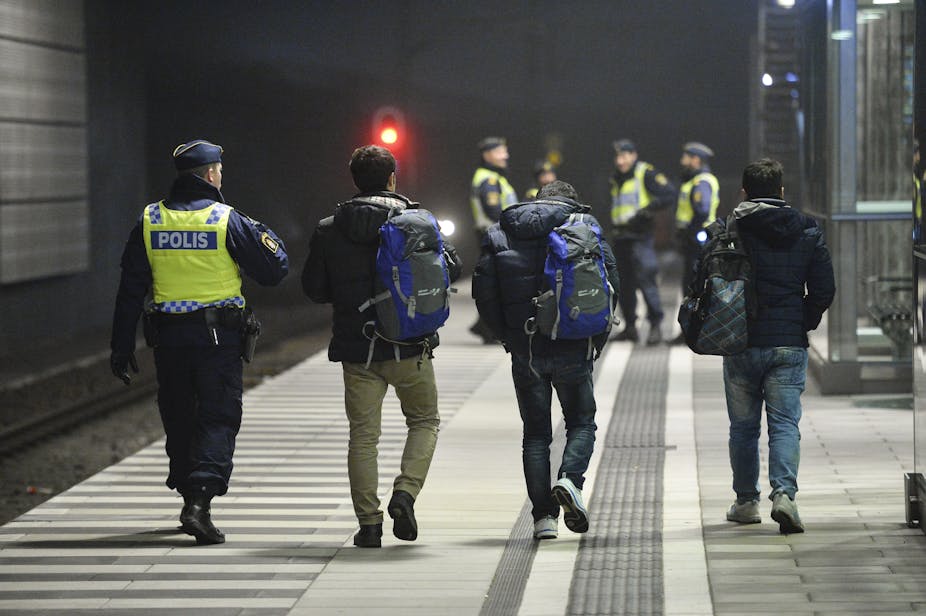According to Donald Trump, Sweden is “having problems like they never thought possible” because of mass migration. But there is no evidence to support the American president’s claim. The crime rate is not affected by the immigration rate, and the Swedish state has actually imposed restrictive measures on asylum seekers in recent years.
Statistics from the Swedish National Council for Crime Prevention for 2014 show a decline in reported offences categorised as “assault, threats, sexual offences, mugging, fraud, or harassment”. The US Department of State ranks Sweden as a country with a “low” crime level, well below the US.
Though foreign-born people are over-represented in Swedish prisons, there is no evidence that shows that the immigration rate affects the national crime rate. The Swedish daily newspaper, Dagens Nyheter, obtained a new form of police record which connects reported cases to newly arrived immigrants. From October 15, 2016 through to January 31, 2017, immigrants were connected to less than 1% of all reported cases.
Opinions about immigrants change and are increasingly polarised in Sweden. In a 2014 European Social Survey most Swedish respondents believed that immigration should be allowed to a “great” or “pretty great” extent. However, by late 2016, a majority in the polls wanted to see a reduced intake of refugees.
This was partly caused by a large increase in asylum seekers coming to Sweden, which peaked at 162,877 in 2015.
Tighter control over asylum seekers
Since late 2015, the Swedish government’s two-pronged strategy of introducing border controls and tougher asylum laws has been effective in drastically reducing the number of asylum seekers arriving in the country. In June 2016, the Swedish parliament passed a temporary law “that limits the possibilities for asylum seekers and their family members to be granted residence permits in Sweden”. The law is intended to be in place for three years.
Another law means that “an asylum seeker does not have a right to assistance” if the “asylum seeker has received a refusal of entry or expulsion order that has entered into force”. Nor are they entitled to assistance if the deadline for voluntary return, which is four weeks, has expired. This means that the asylum seeker loses his or her free housing and daily allowance.
While border controls keep asylum seekers at the gate out, the new laws are deterring asylum seekers who are considering going to Sweden. From the record 162,877 asylum seekers in 2015, the number plummeted to 28,939 in 2016 after the restrictive measures were introduced.
However, the new 2016 law regarding those with an expulsion order has not led to more voluntary departures. Of the 4,200 who lost their right to assistance since June 2016, only 136 have left voluntarily. Another 57 have been forcibly removed and 1,400 have gone underground. The rest have found housing around the country on their own.
Sweden has in no way lost control over its territory, and immigrants remain at the mercy of national asylum and immigration laws. But that has pretty much always been the case in the modern era. A temporary protected status category that Sweden created in 2016 was devised in the 1990s by the US for Central Americans temporarily unable to safely return to their countries because of ongoing armed conflict or other extraordinary temporary conditions. It has the blessing of the UNHCR as “an appropriate multilateral protection response to humanitarian crises, including large-scale influxes.”
A complex issue
The Sweden Democrats, an anti-immigrant party with roots in the neo-Nazi movement, has tried to ride the social media wave created by Trump’s comments on Sweden. Its two top politicians, Jimmie Åkesson and Mattias Karlsson, wrote an article in The Wall Street Journal in February arguing that Trump was right about the problems in Sweden.
But although it’s true that there are serious social issues with some refugee groups and individuals, these problems cannot be blamed on essential cultural differences and simplistic explanations. Some highly conservative mosques in Sweden do preach violent Islamism, but many of Sweden’s mosques oppose them. The Swedish Muslim Council repeatedly condemns Islamist terrorist attacks. Muslim communities, just like any other faith-based community, are highly diverse and often conflicting in their political persuasions and interpretations of doctrine.
There certainly are groups of immigrants where violence against women and homosexuals is practised and condoned. So far this issue has not been successfully addressed, although the Swedish state has introduced initiatives to tackle the problem.
Certain groups of immigrants are also over-represented in crime statistics, but these groups overwhelmingly come from socially and economically marginalised suburbs, such as Rosengård in Malmö and Rinkeby in Stockholm. Suburbs such as these exhibit “very high” unemployment rates. Schools in these immigrant-majority suburbs drastically lag behind those in wealthier areas in terms of student achievement.
Some Muslim communities in Sweden do call for separate Sharia laws, but other Muslim communities have explicitly rejected such a claim because they want to be integrated in Swedish society, legally as well as culturally.
On February 24, Swedish Prime Minister Stefan Löfven issued a statement indicating that Sweden will continue with its restrictive immigration policies. The executive board of his centre-left political party, the Social Democrats, said that Sweden can no longer have immigration laws that differ from those of other EU countries. So the laws from June 2016 seem to have set the tone for a new asylum politics in Sweden.

